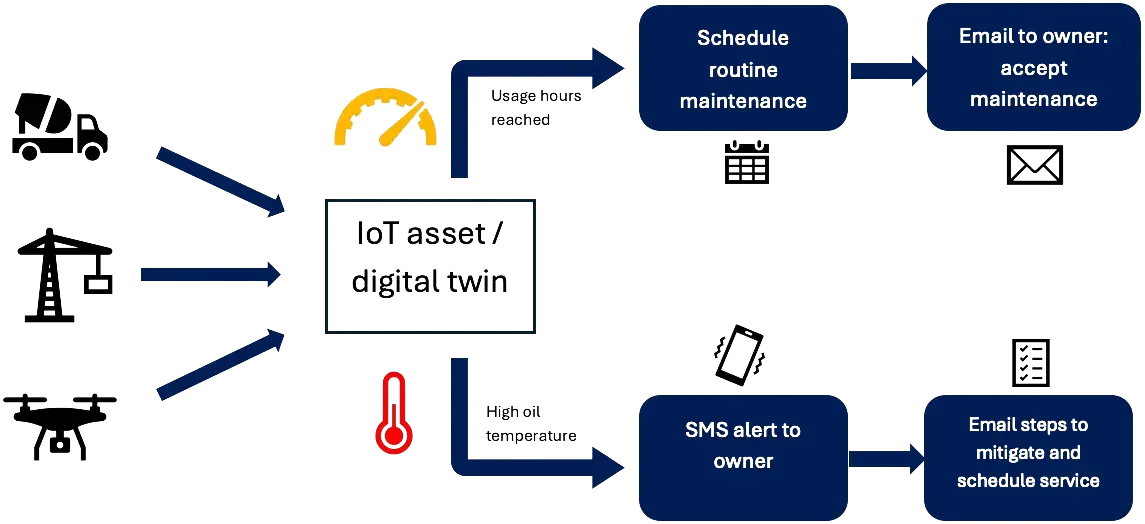
New revenue streams using IoT & AI: Machinery edition
Three step guide for machinery innovators to leverage the power of the Internet of Things & AI
In this blog, we will explore ways in which innovators can create new revenue streams using IoT and AI. We will cover the following topics:
- Identify a problem or a need that IoT can solve or address
- Develop a solution or a service that leverages IoT capabilities
- Validate and monetize your IoT-based offering
Introduction
IoT is transforming various industries and sectors, such as manufacturing, cities, logistics, transportation, and retail, by improving efficiency, productivity, quality, and customer satisfaction. IoT also offers new opportunities for creating value and generating revenue for businesses of all sizes and types.
The Internet of Things (IoT) is the network of physical objects that are embedded with sensors, software, and other technologies that enable them to connect and exchange data with other devices and systems over the internet.
To see how this potential can be untapped in your business, follow this simple three step framwork:
1. Identify a problem or a need that IoT can solve or address
The first step to creating a new business using IoT is to identify a problem or a need that exists in your market that IoT can solve or address. This can be done by conducting market research, customer interviews, surveys, or observations to understand the pain points, challenges, and expectations of your target audience. You can also look for existing gaps, inefficiencies, or opportunities in the current solutions or processes that IoT can improve or enhance.
Some examples of problems or needs that IoT can solve or address are:
- Customer challenges with machinery – warranty or usage problems
- Supply chain visibility and efficiency with real-time tracking, monitoring, and optimization of inventory, assets, and shipments
- Improving crop quantity and quality with smart irrigation, fertilization, and pest control systems
- Increasing customer loyalty and retention with personalized recommendations, offers, and rewards based on IoT data, for example automatic maintenance scheduling
2. Develop a solution or a service that leverages IoT capabilities
The next step to creating a new business using IoT is to design a solution or a service that leverages IoT capabilities to solve or address the need that you have identified. Usually the development is started by analysing what is already there: existing data, devices and systems. After this you may start looking for the missing blocks. Remember to keep in mind the objective what you are trying to achieve. Technology is only one part of the equation, it is an enabler for the business: in the bigger picture business is where you should concentrate.
Examples of workflows that leverage IoT capabilities:

The service itself is usually a collection of multiple small pieces which each bring their own value. To help visualize the offering create a portfolio of all the pieces and write down the value each piece brings. Features and technology are not where the business it at. It is the value that you bring to customers.
3. Validate and monetize your IoT-based offering
The final step to creating a new business or revenue stream using IoT is to validate and monetize your IoT-based offering. This can be done by testing and iterating your IoT solution or service with your target customers, partners, and stakeholders to get feedback, insights, and validation. You can also measure and evaluate the performance, impact, and value of your IoT solution or service using key metrics, such as user satisfaction, retention, engagement, revenue, and profit. You can then monetize your IoT-based offering by choosing a suitable business model, such as subscription, pay-per-use, freemium, or advertising, and setting a competitive price, based on the value proposition, market demand, and customer willingness to pay.
The value streams can be combined from multiple elements:
- New service revenue stream – e.g. remote expert service with monthly payment
- Marketing benefit with new technologies added to products
- Optimization of services – e.g. expert training & usage optimization
- Completely new business models: pay-per-use
- Opening new markets by enabling remote control and updates
In the end everything is related to how to stay afloat on the dynamic markets of today. By leveraging IoT you can mitigate risks, keep your customers loyalty and create new business.
Scroll to see some examples of services and solutions for industrial machinery:
The author has been a heavy machinery enthusiast since early childhood.
Author








